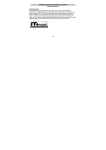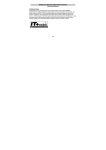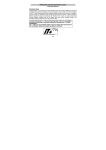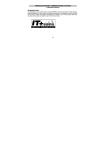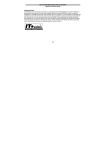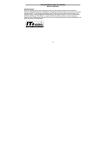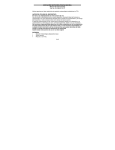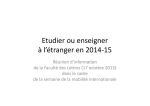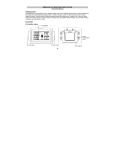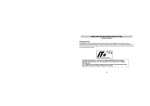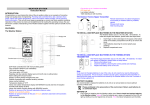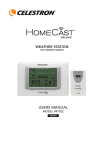Download Technoline WS 9611-IT weather station
Transcript
WIRELESS 433 MHz WEATHER CLOCK Instruction Manual INTRODUCTION: Congratulations on purchasing this fancy Weather clock with wireless 433MHz transmission of outdoor temperature and display of indoor temperature and humidity. It is further acting as a DCF-77 radio controlled clock with calendar display and alarm clock function. In addition, sunrise/ sunset/ sun duration time as well as the moon phase are shown. With the totally 15 different weather forecast icons featured by "weather man", users can easily observe the forecast weather condition and will no longer worry the sudden weather change. This innovative product is ideal for use in the home or office. 42 FEATURES: The Weather clock Battery compartment cover LCD Display Function Keys Function Keys Foldout Stand DCF-77 Radio controlled time with manual setting options DCF Time reception ON/OFF 12/24 hour display Hour, minute and second time display Calendar (weekday, date, month and year) Time zone option ±12 hours Alarm with snooze function Snooze setting Weather forecasting with 15 easy-to-read weather forecast signs featured by weather man 43 Weather forecasting icon sensitivity setting Temperature display in degrees Celsius (°C) or Fahrenheit (°F) selectable Indoor and outdoor temperature display with MIN/MAX recording Indoor humidity reading displayed as RH% with MIN/MAX recordings All MIN/MAX temperature recordings show date and time received All MIN/MAX recordings can be reset Display of sunrise time, sunset time and sun duration in 28 cities 12 Moon phases display throughout the year Can take up to three outdoor transmitters LCD contrast setting LED backlight Table standing/ Wall mounting The Outdoor Temperature Transmitter Holder Remote transmission of outdoor temperature to Temperature Station by 433 MHz Shower proof casing Wall mounting case Mounting at a sheltered place. Avoid direct rain and sunshine 44 HOW TO INSTALL AND REPLACE BATTERIES IN THE WEATHER CLOCK The Weather clock uses 2 x AA, IEC LR6, 1.5V batteries. To install and replace the batteries, please follow the steps below: 1. Remove the cover at the back of the Weather clock. 2. Insert batteries observing the correct polarity (see marking). 3. Replace compartment cover. HOW TO INSTALL AND REPLACE BATTERIES IN THE TEMPERATURE TRANSMITTER The Temperature transmitter uses 2 x AA, IEC LR6, 1.5V batteries. To install and replace the batteries, please follow the steps below: 1. Remove the battery cover. 2. Insert the batteries, observing the correct polarity (see marking). 3. Replace the battery cover on the unit. 45 Note: In the event of changing batteries in any of the units, all units need to be reset by following the setting up procedures. This is because a random security code is assigned by the transmitter at start-up and this code must be received and stored by the Weather clock in the first 3 minutes of power being supplied to it SETTING UP: 1. 2. 3. 4. First, insert the batteries into the Weather clock (see “How to install and replace batteries in the Weather clock”). Once the batteries are in place, all segments of the LCD will light up briefly and a short signal tone will sound. Following some test data display, the indoor temperature and humidity, the time as 0:00 the date as 1.1. 05 and the "weather man" icon will be displayed. If the indoor temperature and humidity are not displayed after 30 seconds, remove the batteries and wait for at least 10 seconds before reinserting them. Once the indoor data is displayed proceed to step 2. Immediately after and within 3 minutes of activating the Weather clock, place the batteries into the transmitter (see “How to install and replace batteries in the Temperature transmitter“). After inserting the batteries into the transmitter, the Weather clock will start receiving data from the transmitter. The outdoor temperature should then be displayed on the Weather clock. If this does not happen after 15 minutes, the batteries will need to be removed from both units and reset from step 1. The Weather clock can take up to 3 remote transmitters. If you have purchased additional transmitters, follow step 2 for all extra transmitters. However, ensure that you leave 10 seconds in between the reception of the last transmitter and the setup of the following transmitter. The Weather clock will number the transmitters in 46 5. 6. 7. the order of set-up, i.e. the first transmitter will have the temperature displayed with the number 1 against it and so on. Before all the transmitters are set up, there is a testing period, during which the display switches quickly between all the received transmitters at random, according to which random transmission it receives. Pressing any key will stop this process. The process also stops automatically if up to 3 transmitters are received or no keys are pressed for a few minutes. Once the remote temperature has been received and displayed on the Weather clock, the DCF-77 time code reception is automatically started. This takes typically between 3-5 minutes in good conditions. This time period is an excellent opportunity to locate the transmitter(s) in suitable location(s) outdoors. In order to ensure sufficient 433 MHz transmission however, this should under good conditions be no more than 100 meters from where the Weather clock will be finally positioned (see notes on “Positioning the temperature transmitter” and “433 MHz Reception”). If after 10 minutes, the DCF time has not been received, use the SET key to manually enter a time initially The clock will automatically attempt to receive the DCF time at each full hour. When this is successful, the received time will override the manually set time. The date is also updated with the received time. (Please refer also to notes on “DCF-77 Radio controlled Time” and “Manual Time Setting”). 47 BATTERY CHANGE: It is recommended to replace the batteries in all units on an annual basis to ensure optimum accuracy of these units. Please participate in the preservation of the environment. Return used batteries to an authorized depot. 48 FUNCTION KEYS: Weather clock: The Weather clock has five easy to use function keys. SNOOZE/ SUN key SET key ALM key MIN/ MAX key CH/ + key 49 SET key (Setting): To enter the set mode for the following functions: LCD contrast, Time zone, Time Reception ON/OFF, 12/24 hour display, Manual time, Year, Date, Sunrise/ sunset city location, Snooze time duration, °C/°F, and Weather forecast sensitivity settings. To toggle between the display of "Weekday + date + month", "Second", "Alarm time", and "Date + month + year" To press and hold for 3 seconds to reset at the same time the maximum/ minimum temperature and humidity records of indoor and the currently selected outdoor channel (will reset all records to current level) To stop the alarm To switch on the backlight MIN/ MAX To toggle between the maximum/ minimum outdoor temperature and maximum/ minimum indoor temperature and humidity data Note: The Time/date shown is corresponding to MIN/MAX temperature data. To stop the alarm To switch on the backlight ALM key (alarm) Press for about 3 seconds to enter the Alarm setting mode To activate/ deactivate the alarm To stop the alarm To switch on the backlight 50 CH/ + key To toggle between the Outdoor transmitters 1, 2 and 3 (if more than 1 transmitter is used) To adjust LCD contrast, time zone, Time Reception ON/OFF, 12/24 hour display, hour, minute, year, month, day, snooze time duration, °C/ °F and weather forecasting icon sensitivity in setting modes To adjust the alarm time in alarm setting mode To stop the alarm To switch on the backlight SNOOZE/ SUN key To activate the snooze function for the alarm To toggle between the sunrise time, sunset time, sun duration in the Sun display To exit manual setting mode and alarm setting mode To switch on the backlight 51 LCD SCREEN AND SETTINGS: DCF Tower Icon (for time reception) Weather Tendency icon Alarm icon Indoor Temperature in °C Time Calendar Indoor Relative Humidity % Outdoor Temperature in °C Moon phase display Sunrise/ sunset display Weather Forecast icon (Weather boy) Outdoor Number showing Reception Transmitter unit Signal For better distinctness the LCD screen is split into 5 sections displaying the information for time, date, weather forecast, indoors and outdoors. 52 Section 1 - TIME AND CALENDAR In normal mode display of radio controlled time. A reception tower symbol will be shown indicating that the DCF-77 time signal is scanned for (flashing) or received (steady). Note: The symbol will not be shown when radio time reception is not successful or when time reception function is turned off. Display of "Weekday + date + month", "Second", "Alarm time" or "Date + month + year" In normal display, the alarm icon will be shown when the alarm is turned on. Or when the snooze function is activated, the alarm icon will be flashing. Section 2 - Moon phase and Sunrise / Sunset Display the sunrise, sunset, and sun duration time Display the 12 different moon phase Section 3 - WEATHER ICON (FEATURED BY WEATHER MAN) Display of the weather to be expected in form of 24 fancy weather symbols (featured by Weather man) which change their appearance depending on the air pressure development and the current outdoor temperature. Format of the weather man icons refers to the "WEATHER FORECAST AND TENDENCY" Section 4 - INDOOR TEMPERATURE AND HUMIDITY Display of the current indoor temperature and humidity. By pressing the MIN/ MAX key, display of the stored MIN/MAX indoor temperature and humidity, with simultaneous display of MIN/ MAX symbol in Section 5. 53 Section 5 - OUTDOOR TEMPERATURE Display of the current outdoor temperature. By pressing the MIN/ MAX key, display of the stored MIN/MAX outdoor temperature with simultaneous display of a MIN or MAX symbol. By pressing the CH/ + key, display of outdoor sensors (up to three outdoor transmitters). The number 1, 2 or 3 will be shown. A signal reception symbol will be shown indicating that receiver is receiving outdoor temperature. DCF-77 RADIO CONTROLLED TIME: The time base for the radio controlled time is a Cesium Atomic Clock operated by the Physikalisch Technische Bundesanstalt Braunschweig which has a time deviation of less than one second in one million years. The time is coded and transmitted from Mainflingen near Frankfurt via frequency signal DCF-77 (77.5 kHz) and has a transmitting range of approximately 1,500 km. Your radio-controlled Weather clock receives this signal and converts it to show the precise time in summer or wintertime. The quality of the reception depends greatly on the geographic location. In normal cases, there should be no reception problems within a 1,500 km radius around Frankfurt. Once the outdoor temperature is displayed on the Weather clock after initial set-up, the DCF tower icon in the clock display will start flashing in the upper left corner. This indicates that the clock has detected that there is a radio signal present and is trying to receive it. When the time code is received, the DCF tower becomes permanently lit and the time will be displayed. If the tower icon flashes, but does not set the time or the DCF tower does not appear at all, then please take note of the following : 54 Recommended distance to any interfering sources like computer monitors or TV sets is a minimum of 1.5 - 2 meters. Within ferro-concrete rooms (basements, superstructures), the received signal is naturally weakened. In extreme cases, please place the unit close to a window and/or point its front or back towards the Frankfurt transmitter. MANUAL SETTINGS: The following manual settings can be done in the setting mode: LCD contrast setting Time zone setting Time reception ON/OFF setting 12/24-Hour setting Manual time setting Calendar setting Sunrise/ Sunset city location Snooze setting °C/ °F setting Weather forecasting icon sensitivity setting Press and hold the SET key for about 3 second to advance to the setting mode: LCD CONTRAST SETTING flashing 55 The LCD contrast can be set to 8 different levels to suit the users needs (default LCD contrast setting is LCD 5). To set the desired contrast level: 1. The above display will be seen. Press the CH/ + key to select the level of contrast desired. 2. Press the SET key to confirm and enter the “Time Zone setting” or exit the setting mode by pressing the SNOOZE/ SUN key TIME ZONE SETTING: flashing The time zone default of the Weather clock is 0. To change to another time zone: 1. Press the SET key after completing the LCD contrast setting in order to enter the time zone setting (flashing). 2. Using the CH/ + key, set the time zone. The range runs from 0 to +12 and then runs from -12 back to 0 in consecutive 1hour intervals. 3. Press the SET key to confirm and enter the “Time Reception ON/OFF setting” or exit the setting mode by pressing the SNOOZE/ SUN key 56 TIME RECEPTION ON/OFF SETTING Flashing (time reception icon) Digit flashing In area where reception of the DCF-77 time is not possible, the DCF-77 time reception function can be turned OFF. The clock will then work as a normal Quartz clock (Default setting is ON). 1. The digit “ON” and the time reception icon will start flashing on the LCD. 2. Use the CH/ + key to turn OFF the time reception function. 3. Confirm with the SET key and enter the “12/24-Hour Display setting” or exit the setting mode by pressing the SNOOZE/ SUN key. Note: If the Time Reception function is turned OFF manually, the clock will not attempt any reception of the DCF time as long as the Time Reception OFF function is activated. The Time Reception icon will not be displayed on the LCD. 57 12/24 HOUR TIME DISPLAY SETTING flashing 1. 2. 3. After setting time reception ON/OFF, press the SET key, “12h” or “24h” flashes in the LCD. (default 24 h) Press the CH/ + key to select the “12h” or “24h” display mode. Press the SET again to confirm and to enter the “Manual Time setting” or exit the setting mode by pressing the SNOOZE/ SUN key. Note: When 24h mode display is selected, the calendar format will be date and month display. When 12h mode display is selected, the calendar format will be month and date display. 58 MANUAL TIME SETTING In case the Weather clock is not able to detect the DCF-signal (disturbances, transmitting distance, etc.), the time can be manually set. The clock will then work as a normal Quartz clock. Minutes (flashing) Hours (flashing) To set the clock : 1. The hour and minute digits start flashing in the time display section. 2. Use the CH/ + key to adjust the hours and then press SET key to go to the minute setting. 3. The minute will be flashing. Press the CH/ + key to just the minutes. 4. Confirm with the SET key and enter the “Calendar Setting” or exit the setting mode by pressing the SNOOZE/ SUN key Note: The unit will still try to receive the signal at each full hour despite it being manually set. When it does receive the signal, it will change the manually set time into the received time. During reception attempts the DCF tower icon will flash. If reception has been unsuccessful, then the DCF tower icon will not appear but reception will still be attempted the following hour. 59 CALENDAR SETTING Year "Date. Month." (for 24h time display) "Month. Date." (for 12h time display) The date default of the Weather clock is 1. 1. of the year 2005 after initial set-up. Once the radio-controlled time signals are received, the date is automatically updated. However, if the signals are not received, the date can also be set manually. To do this: 1. Using the CH/ + key, set the year required. The range runs from 2005 to 2029 (default is 2005). 2. Press the SET key to enter the month setting mode. 3. The month digit will be flashing. Press the CH/ + key to set the month and then press the SET key to go to the date setting. 4. The date digit will be flashing. Press the CH/ + key to set the date. 5. Confirm with the SET key and enter the “Sunrise, sunset and sun duration” or exit the setting mode by pressing the SNOOZE / SUN key. 60 SUNRISE, SUNSET AND SUN DURATION The Sun Clock will automatically calculate the sunrise, sunset and sun duration time based on the city location and the set date. (see “Sun setting“) 1. The short form of city name will start flashing (default “F“). Using the CH/ + key, select the city location: Short form of City location (flashing) 28 cities can be chosen from and every city is displayed in short-form (e.g.: AMS=Amsterdam). The cities are displayed as follows: Frankfurt =F München =M Flensburg =FL Magdeburg =MD Hannover =H Mainz =MZ Bremen =HB Nürnberg =N Helsinki =HEL Oslo =OSL Hamburg =HH Paris =PAR Rostock =HRO Stuttgart =S Insbruck =INS Saarbrücken =SB London =LDN Stockholm =STO Luxemburg =LUX Vienna (Wien) =VIE 61 Zürich =ZRH Amsterdam =AMS Berlin =B Brüssel =BRU Copenhagen =CPH Düsseldorf = D Dresden =DD Erfurt = EF 2. Confirm with the SET key and enter the “Snooze setting" or exit the setting mode by pressing the SNOOZE / SUN key. SNOOZE SETTING: flashing The snooze time can be set OFF or to a maximum time of 30 minutes (default is 10 minutes): 1. The snooze time (in minute) digit will be flashing. Use the CH/ + key to set the snooze time (in minute). Each pressing of the key will increase the snooze time by 5 minutes. The snooze can also be set OFF when the “OFF” digit is being displayed. 2. Confirm with the SET key and enter the “ºC / ºF temperature unit setting” or exit the manual setting mode by pressing the SNOOZE/ SUN key. Note: If the snooze time has been set “OFF”, the snooze function will not be activated. 62 °C/°F TEMPERATURE UNIT SETTING flashing The default temperature reading is set to °C (degree Celsius). To select °F (degree Fahrenheit): 1. The “°C” will be flashing, use the CH/ + key to toggle between “°C” and “°F”. 2. Once the desired temperature unit has been chosen, confirm with the SET key and enter the “Weather Forecast Icon Sensitivity setting” or exit the setting mode by pressing the SNOOZE/ SUN key. 63 WEATHER FORECASTING ICON SENSITIVITY SETTING For locations with rapid changes of weather conditions, the threshold can be set to a different level for faster display of changing weather conditions. Using the CH/ + key to set the weather sensitivity level. There are 3 levels of setting: 1, 2 and 3; level 1 is the most sensitive setting, level 3 is the least sensitive setting (default setting is "2"). 1. Confirm with the SET key and exit the Manual settings. flashing flashing 64 Alarm icon flashing ALARM SETTING: flashing To set alarm: 1. Press and hold ALM for about 3 seconds until the alarm time display flashes. 2. The hour digit and the alarm icon will be flashing. Press the CH/ + key to adjust the hour. 3. Press ALM button once and minute digit will be flashing. User shall then press CH/ + button to set the minute. 4. Press ALM button once to confirm the setting. 5. To activate/ deactivate the alarm function, press the ALM button once. The display of the alarm icon represents that the alarm is "ON". Note: The duration of alarm sounding is 120 seconds 65 SNOOZE SETTING AND STOPPING THE ALARM: 1. 2. When the alarm is sounding, press the SNOOZE/ SUN key to activate the snooze function. The alarm will stop and re-activate after the time interval of the snooze time pre-set by user. To stop the alarm completely, press any keys other than the SNOOZE/ SUN key. WEATHER FORECAST AND TENDENCY: The weather forecast icons (Weather man): One of the 15 different weather icons (featured by Weather man with different clothing) is displayed in the centre of LCD, which indicates the different forecast weather condition due to air pressure level (Sunny, Sunny + Cloudy or Cloudy + Rainy) and the current outdoor temperature (Temperature value detected by Channel 1): 66 26 C 19 – 25.9 C Sunny Cloudy Rainy 67 10 – 18.9 C 0– 9.9 C <0 C Note: After setting up, readings for weather forecasts should be disregarded for the next 12-24 hours. This will allow sufficient time for the Weather clock to collect air pressure data at a constant altitude and therefore result in a more accurate forecast. Common to weather forecasting, absolute accuracy cannot be guaranteed. The weather forecasting feature is estimated to have an accuracy level of about 75% due to the varying areas the Weather clock has been designed for use in. In areas that experience sudden changes in weather (for example from sunny to rain), the Weather clock will be more accurate compared to use in areas where the weather is stagnant most of the time (for example mostly sunny). If the Weather clock is moved to another location significantly higher or lower than its initial standing point (for example from the ground floor to the upper floors of a house), remove the batteries and re-insert them after about 30 seconds. By doing this, the Weather clock will not mistake the new location as being a possible change in airpressure when really it is due to the slight change of altitude. Again, disregard weather forecasts for the next 12 to 24 hours as this will allow time for operation at a constant altitude. THE WEATHER TENDENCY INDICATOR Working together with the weather icons are the weather tendency indicators (the upward and downward arrow located near the Weather man). When the indicator points upwards, it means that the air-pressure is increasing and the weather is expected to improve, but when indicator points downwards, the air-pressure is dropping and the weather is expected to become worse. 68 Therefore, user may see how the weather has changed and is expected to change. For example, if the indicator is pointing downwards together with cloudy icons, it means that the last noticeable change in the weather was when it was sunny (the sunny icon only). Therefore, the next change in the weather will be the cloudy icons since the indicator is pointing downwards. Note: Once the weather tendency indicator has registered a change in air pressure, it will remain permanently visualized on the LCD. DISPLAY OF INDOOR TEMPERATURE AND HUMIDITY READING: The indoor temperature and humidity are measured automatically and displayed on the fourth section of the LCD. Indoor Temperature in °C Indoor Relative Humidity % Minimum icon 69 DISPLAY OF OUTDOOR TEMPERATURE: Outdoor Reception Symbol Outdoor temperature in C Transmitter identification No. (only shown when more than one transmitter is used) Maximum icon The last LCD section shows the outdoor temperature, a reception symbol and a channel number under the temperature will also show if more than one transmitter has been used. DISPLAY OF INDOOR MAXIMUM AND MINIMUM RECORDS: 1. 2. In normal display mode, press the MIN/ MAX button three times. The maximum indoor temperature and humidity will be shown. Also the date and time of recording this temperature will be displayed. Press the MIN/ MAX button once more to display the minimum indoor temperature and humidity. Also the date and time of recording this temperature will be displayed. 70 RESETTING THE INDOOR MAXIMUM/ MINIMUM RECORDS 1. 2. In normal display mode, press the MIN/ MAX button to advance to the MIN/ MAX display. Press and hold the SET key for about 3 seconds, this will reset all indoor minimum and maximum data recorded to the current time, date, temperature and humidity. The max/ min temperature of the currently selected outdoor channel will also be rest at the same time DISPLAY OF OUTDOOR MAXIMUM AND MINIMUM RECORDS: 1. 2. 3. In normal display mode, press the CH/ + button to select the desired channel. The channel ID will be displayed above the outdoor temperature reading. Press the MIN/MAX button, the max temperature of the selected channel will be displayed. Also the date and time of recording this temperature will be displayed. Press the MIN/MAX button once more, the min temperature of the selected channel will be shown. Press the ALM button to go back to the normal display mode. RESETTING THE OUTDOOR MAXIMUM/ MINIMUM RECORDS Note: It is required to reset The outdoor max min temperature records of different channels separately. 1. In normal display mode, press the CH/ + button to select a channel. The channel ID will be displayed above the outdoor temperature reading. Note: The transmitter number will only be displayed if more than one transmitter is applied. 2. Press the MIN/ MAX button once. The max icon will be displayed. 71 3. Press and hold the SET button for about 3 seconds, this will reset all outdoor minimum and maximum temperature recorded to the current time, date and temperature. Note: The max/ min temperature records of the indoor channel will also be reset at the same time. SUNSET/ SUNRISE/ SUN DURATION TIME: Sunrise time/ Sunset time/ Sun duration time Sunrise/ sunset display Shortform of City name Press the SNOOZE/ SUN key to toggle between the sunrise, sunset, and sun duration time: Sunrise time Sunrise icon Sunrise time 72 Sunset time Sunset icon Sunset time Sun duration time (total number of hours of sunlight on the day) Sun duration time icon Sun duration time (hh:mm) THE MOON PHASE The Moon icon of the Weather clock will also display 12 different Moon phases according to the set calendar. Note: In the southern hemisphere, the phases of the moon are same but the shape of the moon is mirror inverted. 73 New Moon Full Moon Large Waning Gibbous Small Waxing Crescent Large Waxing Crescent Small Waning Gibbous Last Quarter First Quarter Large Waning Crescent Small Waxing Gibbous Small Waning Crescent Large Waxing Gibbous LED BACK-LIGHT The LED back-light will be automatically switched ON when any key is pressed. The LED back-light will be switched on for approximately 9 seconds before automatically switching OFF. 74 TEMPERATURE TRANSMITTER: The range of the Temperature transmitter may be affected by the temperature. At cold temperatures the transmitting distance may be decreased. Please bear this in mind when placing the transmitter. 433 MHz RECEPTION The Weather clock should receive the temperature data within 15 minutes after set-up. If the temperature data is not received 15 minutes after setting up (not successfully 3 times continuously, the outdoor display shows “- - -” ), please check the following points: 1. The distance of the Weather clock or transmitter should be at least 1.5 to 2 meters away from any interfering sources such as computer monitors or TV sets. 2. Avoid positioning the Weather clock onto or in the immediate proximity of metal window frames. 3. Using other electrical products such as headphones or speakers operating on the same signal frequency (433MHz) may prevent correct signal transmission and reception. 4. Neighbors using electrical devices operating on the 433MHz signal frequency can also cause interference. Note: When the 433MHz signal is received correctly, do not re-open the battery cover of either the transmitter or Weather clock, as the batteries may spring free from the contacts and force a false reset. Should this happen accidentally then reset all units (see Setting up above) otherwise transmission problems may occur. The transmission range is about 100 m from the transmitter to the Weather clock (in open space). However, this depends on the surrounding environment and interference levels. If no reception is possible despite the observation of these factors, all system units have to be reset (see Setting up). 75 POSITIONING WEATHER CLOCK: The Weather clock comes complete with a foldout stand that gives the option of table standing or wall mounting. To wall mount: 1. 2. Fix a screw into the desired wall, leaving the head extended out the by about 5mm. Using the Weather clock’s hanging hole, carefully hang it onto the screw. Note: Always ensures that the unit locks onto the screw head before releasing. 76 POSITIONING THE TEMPERATURE TRANSMITTER: The Temperature transmitter can be placed onto any flat surface or wall mount using the bracket which doubles as a stand or wall mount base. To wall mount: 1. Secure the bracket onto a desired wall using the screws and plastic anchors. 2. Clip the transmitter onto the bracket. Note: Before permanently fixing the transmitter wall base, place all units in the desired locations to check that the outdoor temperature reading is receivable. In event that the signal is not received, relocate the transmitters or move them slightly as this may help the signal reception. CARE AND MAINTENANCE : Extreme temperatures, vibration and shock should be avoided as these may cause damage to the unit and give inaccurate forecasts and readings. When cleaning the display and casings, use a soft damp cloth only. Do not use solvents or scouring agents as they may mark the LCD and casings. Do not submerge the unit in water. 77 Immediately remove all low powered batteries to avoid leakage and damage. Replace only with new batteries of the recommended type. Do not make any repair attempts to the unit. Return them to their original point of purchase for repair by a qualified engineer. Opening and tampering with the unit may invalidate their guarantee. Do not expose the units to extreme and sudden temperature changes, this may lead to rapid changes in forecasts and readings and thereby reduce their accuracy. SPECIFICATIONS: Temperature measuring range: Indoor : -9.9ºC to +59.9ºC with 0.1ºC resolution (14.2°F to +139.8°F with 0.2°F resolution, “OF.L” displayed if outside this range) Outdoor : -29.9ºC to +69.9ºC with 0.1ºC resolution (-21.8°F to +157.8°F with 0.2°F resolution, “OF.L” displayed if outside this range) Relative humidity measuring range: Indoor : 1% to 99% with 1% resolution (displays “- -” when lower than 1 %; displays "99" % if higher than 99 %) Indoor temperature checking interval : every 15 seconds Indoor humidity checking interval : every 20 seconds Outdoor temperature reception : every 5 minutes Power supply: Weather clock Temperature transmitter Battery life cycle : : : 2 x AA, IEC, LR6, 1.5V 2 x AA, IEC, LR6, 1.5V Approximately 12 months (Alkaline batteries 78 recommended) Dimensions (L x W x H) Weather clock Temperature transmitter : : 124.3 x 28.4 x 92.5 mm 39 x 21 x 128 mm (wall bracket excluded) LIABILITY DISCLAIMER : The electrical and electronic wastes contain hazardous substances. Disposal of electronic waste in wild country and/or in unauthorized grounds strongly damages the environment. Please contact your local or/and regional authorities to retrieve the addresses of legal dumping grounds with selective collection. All electronic instruments must from now on be recycled. User shall take an active part in the reuse, recycling and recovery of the electrical and electronic waste. The unrestricted disposal of electronic waste may do harm on public health and the quality of environment. As stated on the gift box and labeled on the product, reading the “User manual” is highly recommended for the benefit of the user. This product must however not be thrown in general rubbish collection points. The manufacturer and supplier cannot accept any responsibility for any incorrect readings and any consequences that occur should an inaccurate reading take place. This product is designed for use in the home only as indication of the temperature. This product is not to be used for medical purposes or for public information. The specifications of this product may change without prior notice. This product is not a toy. Keep out of the reach of children. No part of this manual may be reproduced without written authorization of the manufacturer. 79 R&TTE Directive 1999/5/EC Summary of the Declaration of Conformity : We hereby declare that this wireless transmission device does comply with the essential requirements of R&TTE Directive 1999/5/EC. 80







































